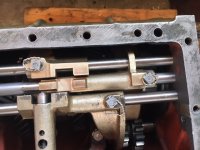I'm not a tribologist, but I've asked the same questions. Most don't consider the lubricant in a manual transmission to be particularly stressed, like in an engine--with shear forces and fuel/water and other contamination--or the fluid in an automatic transmission, or in a differential, where the shear forces tend to heat the oil to extremes. Most automatics, esp. when used for towing have a fluid cooler, often embedded in the radiator, and a good 'track car' will probably have a differential cooler (my otherwise high-performance Mustang is limited on the track because of this). That's why pretty much any decent lubricant, including ATF, a good dino oil or synthetic will work fine in a manual transmission car. The OD may have some special requirement, maybe for proper friction on the cone clutch, but I've not heard of any particular fluid causing problems. Nor does a manual gearbox require multi-vis oil with a wide viscosity spread; oils like 0W-30, 5W-50, etc. aren't necessary because there is no need to move the oil to an engine top end at startup, for example. I think one advantage of a multi-vis with a small viscosity spread, like MT-90, which is rated 75W-90, is that is will retain its viscosity as the box heats up and clearances become greater (I noticed when I first installed it that the OD seemed to engage a bit quicker when hot).
So, I think the answer as to why there aren't any scientific studies on gearbox requirements is that they aren't critical, any good oil will work (even vegetable oil from your kitchen, for a few miles anyway). It comes down to 'operator impression,' and I like full-synthetics in my gearboxes but--not necessarily in engines because that oil gets changed often--and I know that a good synthetic is good for 50K miles or more. Note there is one exception: warranties. First thing I did for my Mustang, with a manual transmission that is not held in high regard by most, was to put a good full-syn oil in, and it specifically met the specs from Ford so, hopefully, there will be no warranty issues. My old Ford tractors call for GL-1 for their hydraulics and gearboxes, and I had to special order some but, in hindsight, it probably wasn't necessary (GL-1 was probably what was available in 195X).
You can only see parts of some of the gears, but here's what my BJ8's gearbox looked like with original gears at about 200K miles:


 Hey there Guest!
Hey there Guest!
 smilie in place of the real @
smilie in place of the real @
 Pretty Please - add it to our Events forum(s) and add to the calendar! >>
Pretty Please - add it to our Events forum(s) and add to the calendar! >> 


 A friendly reminder - be careful what links you click on here. If a link is posted by someone you don't know, or the URL looks fishy, DON'T CLICK. Spammers sometimes post links that lead to sites that can infect your computer, so be mindful what you click.
A friendly reminder - be careful what links you click on here. If a link is posted by someone you don't know, or the URL looks fishy, DON'T CLICK. Spammers sometimes post links that lead to sites that can infect your computer, so be mindful what you click.